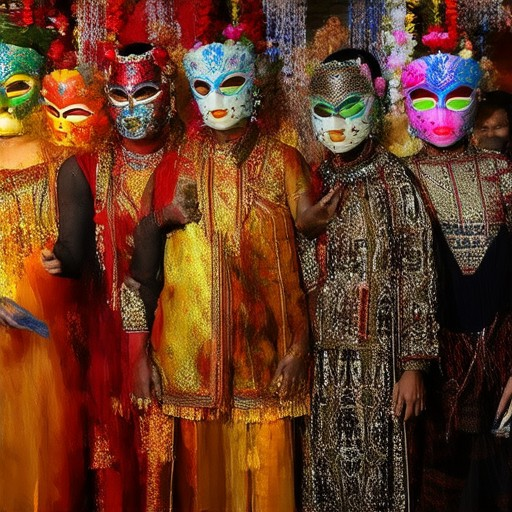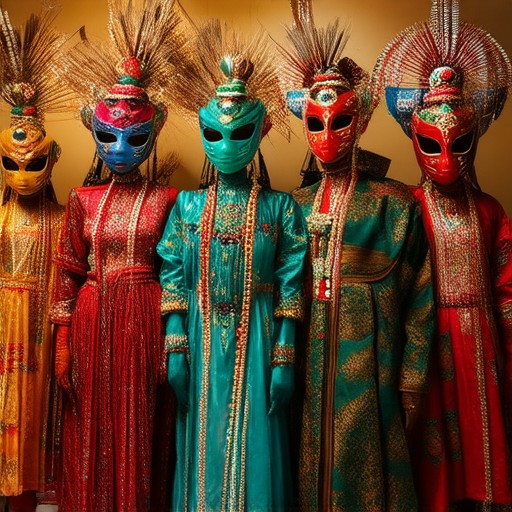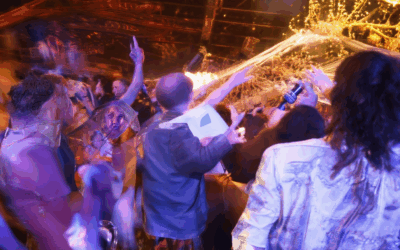The evolution of cultural events trends continues to shape our societies, reflecting the ever-changing values and interests of diverse communities. From traditional festivals to cutting-edge digital experiences, cultural trends offer a window into the soul of our times. Understanding these shifts not only enriches our cultural awareness but also helps us navigate an increasingly interconnected world. Whether it’s the rise of cultural festivals celebrating heritage or the influence of global events shaping modern discourse, staying attuned to these trends is essential for anyone looking to stay informed and engaged. This article delves into the latest developments, exploring how cultural trends evolve, their impact on society, and the role of platforms like TikTok in propagating viral movements. By examining regional variations and the forces driving change, we aim to provide a comprehensive overview of the cultural landscape as it stands today.
Key Takeaways
- Cultural Trends Shape Societies: Cultural trends reflect societal values and influence behaviors, attitudes, and norms, driving significant changes in daily life.
- Technological Adoption Drives Innovation: Rapid integration of technologies like AI and smartphones reshapes culture, altering communication and work practices.
- Social Media Influences Culture: Platforms like TikTok foster creativity and viral trends, impacting fashion, music, and social discourse.
- Sustainability Gains Momentum: Growing awareness of climate change pushes eco-friendly practices and renewable energy into the mainstream.
- Remote Work Redefines Norms: The shift to remote work has reevaluated work-life balance and traditional workplace dynamics.
- Globalization Blends Cultures: Hybrid traditions emerge, transcending national boundaries through cultural exchange.
- Health and Wellness Rise: Increased focus on mental health and wellness reflects a shift in societal priorities.
- Digital Natives Lead Change: Generation Z influences trends through their native use of digital platforms and unique communication styles.
- Political Movements Drive Change: Movements like #MeToo and Black Lives Matter reshape cultural norms and spark conversations on equality.
- Economic Shifts Impact Culture: Gig economy and economic changes alter perceptions of work and success.
- AI Integrates Into Daily Life: Artificial intelligence becomes woven into personal productivity and creative industries.
- Four Key Trend Types: Monitoring economic, social, technological, and regulatory trends helps businesses adapt and thrive.
- TikTok as a Cultural Phenomenon: The app’s rise transforms content consumption, fostering creativity and viral trends globally.

What Are Some Current Cultural Trends?
Cultural trends reflect the evolving values, behaviors, and societal norms of a given population. As of 2025, several significant cultural trends are shaping our world:
1. Rise of Streaming Platforms and On-Demand Content Consumption
The shift towards streaming services has revolutionized how people consume media. Platforms like Netflix, Spotify, and Disney+ dominate the market, offering a vast library of movies, TV shows, and music. This trend has led to the rise of “binge culture” and personalized recommendations algorithms.
2. Influence of Social Media on Pop Culture
Social media platforms like TikTok, Instagram, and YouTube have become powerful drivers of cultural trends. Viral challenges, memes, and influencers shape fashion, music, and even political discourse. Brands increasingly rely on these platforms to connect with younger audiences.
3. Growing Interest in Sustainability and Environmental Awareness
There is a rising global consciousness around environmental issues, leading to changes in consumer behavior and corporate practices. Many companies now prioritize eco-friendly packaging, renewable energy sources, and ethical sourcing of materials. This trend is reflected in everything from fashion to food.
4. The Resurgence of Local and Community-Based Movements
People are increasingly valuing local businesses, traditional crafts, and handmade products. This shift is part of a broader movement toward supporting communities and reducing reliance on global corporations. Farmers’ markets, artisanal workshops, and local art exhibitions are becoming popular events.
5. Integration of Technology in Daily Life
Smart devices, wearables, and AI-driven applications are becoming integral to daily life. From smart homes to augmented reality experiences, technology is transforming how we live, work, and interact. This trend is particularly evident in entertainment, education, and healthcare sectors.
6. Shift Toward Health-Conscious Lifestyles
There is a growing emphasis on mental health, wellness, and holistic living. Meditation apps, fitness trackers, and plant-based diets are gaining popularity. Companies are also adopting healthier workplace policies, reflecting a broader societal focus on well-being.
7. The Rise of Virtual Events and Hybrid Work Models
Virtual events and remote work have become the norm in many industries. While the pandemic accelerated this trend, many organizations continue to embrace hybrid models, blending in-person and online interactions. This shift has also led to innovations in event planning and collaboration tools.
8. Increased Political Awareness and Social Activism
Global issues like climate change, social inequality, and human rights are driving widespread activism. Movements like #MeToo, Black Lives Matter, and Fridays for Future have sparked conversations and prompted policy changes. Younger generations are particularly active in these movements.
9. The Comeback of Traditional Crafts and Art Forms
Traditional crafts, such as pottery, weaving, and calligraphy, are experiencing a renaissance. People are seeking slower, more mindful activities as a counterbalance to fast-paced digital lives. Art fairs and craft markets are becoming popular events.
10. Expansion of Gaming Culture
Gaming has gone mainstream, with esports, video games, and gaming conventions attracting massive audiences. This trend has also influenced fashion, music, and even marketing strategies, as brands seek to tap into this passionate fanbase.
These trends reflect the dynamic nature of contemporary culture, shaped by technological advancements, social movements, and changing values. Staying attuned to these shifts can help individuals and businesses adapt to the evolving landscape.
Example of a Popular Culture Event
The Super Bowl halftime show is a prime example of a widely recognized popular culture event. This annual event features performances by renowned musicians and is watched by millions worldwide. It has become synonymous with high-energy performances, iconic moments, and cultural significance. The halftime show often showcases artists from various genres, making it a celebration of music and entertainment.
One notable instance was the 2025 Super Bowl halftime show, headlined by global superstars like Beyoncé, Drake, and Eminem. Their performance captivated audiences, trended globally on social media, and became a defining moment in recent popular culture history. Events like these not only entertain but also have a significant cultural impact, shaping trends and conversations across society.

What Are the Three Cultural Events?
Kenya boasts a rich tapestry of cultural events that celebrate its diverse heritage and traditions. Here are three prominent cultural events:
- Nairobi International Trade Fair – Held annually at the Kenyatta Convention Centre, this event showcases Kenya’s industrial capabilities, agricultural products, and cultural exhibits. It attracts both local and international visitors.
- Mombasa Cultural Festival – Taking place in the coastal city of Mombasa, this festival highlights the region’s rich Swahili culture, with traditional dances, music, and art displays. It’s a vibrant celebration of coastal heritage.
- Lake Victoria Cultural Festival – Located in Kisumu, this festival pays homage to the lake’s significance through performances, boat races, and cultural demonstrations. It’s a celebration of lakeside life and traditions.
These events offer a unique glimpse into Kenya’s cultural diversity and historical richness.
[Learn more about cultural events on our platform](https://1nationentertainment.net/cultural-events).

Cultural Trend
A cultural trend refers to a pattern of behavior, attitude, or value that is widely accepted and practiced within a specific group or society at a particular time. These trends often reflect the collective consciousness and values of a culture and can influence how people live, interact, and express themselves. Cultural trends can emerge from various factors, including technological advancements, social movements, economic shifts, and global interactions.
Examples of Cultural Trends:
- Technological Adoption : The rapid integration of new technologies, such as smartphones and artificial intelligence, has significantly shaped modern culture. People increasingly rely on digital tools for communication, work, and entertainment, leading to new norms and behaviors.
- Social Media Influence : Platforms like Instagram, TikTok, and Twitter have become integral parts of daily life, influencing fashion, language, and how individuals present themselves online.
- Sustainability Awareness : There has been a growing emphasis on eco-friendly practices, renewable energy, and reducing carbon footprints, driven by environmental movements and increased awareness of climate change.
- Remote Work Revolution : The shift towards remote work, accelerated by the COVID-19 pandemic, has changed traditional workplace dynamics and led to a reevaluation of work-life balance.
- Cultural Hybridization : Globalization has led to the blending of cultures, resulting in hybrid traditions, foods, and practices that transcend national boundaries.
- Health and Wellness Focus : There is a rising interest in mental health, fitness, and holistic living, reflected in the popularity of meditation apps, plant-based diets, and wellness retreats.
- Digital Natives : Generation Z and younger generations are native to digital platforms, shaping cultural trends through their unique communication styles and preferences.
- Political Movements : Social and political movements, such as #MeToo, Black Lives Matter, and LGBTQ+ rights advocacy, have influenced cultural norms and sparked conversations about equality and justice.
- Economic Shifts : Changes in the economy, such as gig work and the rise of the gig economy, have impacted cultural perceptions of work and success.
- AI Integration : Artificial intelligence is increasingly woven into everyday life, affecting everything from personal productivity to creative industries.
Evolution and Influence of Cultural Trends:
Cultural trends evolve over time, often building upon previous movements while being shaped by new experiences and challenges. They influence art, literature, fashion, education, and more, serving as a reflection of a society’s values and aspirations. Understanding these trends can provide insight into the shifting tides of human behavior and the ways in which cultures adapt to changing circumstances.
For more in-depth exploration of these topics, visit our dedicated sections on Cultural Trends and related discussions.
What Are the Four Main Types of Trend?
There are four primary types of trends that entrepreneurs and businesses should monitor to stay competitive and informed:
- Economic Trends : These include changes in GDP growth rates, inflation levels, unemployment rates, and consumer spending patterns. Economic trends can significantly impact market demand, supply, and pricing.
- Social Trends : These involve shifts in societal values, demographics, and behaviors. Examples include changing attitudes toward sustainability, healthcare, and technology adoption.
- Technological Trends : Technological advancements drive innovation and change how businesses operate. Trends like AI integration, blockchain, and IoT development are key areas to monitor.
- Regulatory Trends : Changes in laws, regulations, and compliance requirements can affect how companies operate. Staying ahead of these trends helps businesses adapt and remain compliant.
By tracking these trends, businesses can better anticipate market changes and position themselves for success. Whether it’s leveraging emerging technologies or adapting to evolving consumer preferences, understanding these dynamics is crucial for long-term growth and resilience.

TikTok as a Cultural Trend
TikTok has emerged as a significant cultural force, reshaping how content is consumed and shared globally. Its rise to prominence has led to a unique blend of creativity, connectivity, and influence across various demographics.
Content Creation and Expression
TikTok provides a platform for users to create and share short-form videos, enabling self-expression through music, dance, comedy, and storytelling. This has fostered a culture of creativity where individuals can showcase their talents and connect with audiences worldwide.
Viral Trends and Challenges
The app has popularized viral trends and challenges, which have become a staple of internet culture. From the “Dance Tik Tok” challenge to “Charli D’Amelio-inspired dances,” these trends have transcended boundaries, influencing fashion, music, and even corporate marketing strategies.
Political and Social Impact
TikTok has also played a role in political discourse, often serving as a megaphone for youth voices. It has been used to organize campaigns, spread awareness, and engage young voters, making it a powerful tool for social change.
Economic Influence
Beyond culture, TikTok has impacted the economy by creating opportunities for influencers, businesses, and content creators. Its algorithm-driven success has attracted major investments and partnerships, shaping the digital advertising landscape.
Comparison with Competitors
While TikTok competes with platforms like YouTube and Instagram, it distinguishes itself through its focus on short-form video content and algorithmic curation. This has allowed it to carve out a unique niche in the digital space.
Conclusion
TikTok’s integration into daily life has made it more than just an app—it’s a cultural phenomenon that influences trends, politics, and commerce. Its ability to foster connection and inspire innovation continues to drive its growth and evolution.




